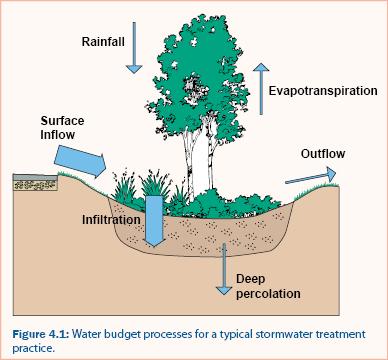
Water Budget Measurement
A.J. Erickson, J.S. Gulliver, R.M. Hozalski, O. Mohseni, J.L. Nieber, B.N. Wilson, P.T. Weiss
A water budget for a stormwater treatment practice is the accounting of water that enters, exits, and is stored by the stormwater treatment practice (equation 4.1). The water budget assigns discharge values to each of the processes that affect the fate of water, including input processes (e.g., direct precipitation into the treatment practice, surface runoff, and conduit or open channel flow) and output processes (e.g., infiltration, evapotranspiration, and conduit or open channel flow). The goal for developing a water budget is to balance the inflows and outflows with minimal error.

It is important to note that this manual does not contain all possible methods of water budget measurement. The intent of this section is to discuss the most common methods and provide guidance for method selection. Those interested in other methods of discharge measurement or other water budget parameter estimation should consult discharge measurement (e.g., Bos 1998, Herschy 1995), fluid mechanics (e.g., Franzini and Finnemore 1997), hydrology (e.g., Bedient and Huber 1992), or other similar texts.
Water Budgets
Water budgets require measurement of all water transport into and out of the stormwater treatment practice, including open channel flow, conduit flow, over-land flow, direct precipitation, evaporation, transpiration, infiltration, ground water seepage, and any other influent sources and effluent transport processes. Figure 4.1 is an illustration of water budget processes on a typical stormwater treatment practice and equation 4.1 can be used to calculate the mass balance of water from these processes.

Measuring all sources of water transport may not be practical or possible. Some stormwater treatment practices (e.g., infiltration basins) do not have a central effluent location that can be measured easily, and some transport processes (e.g., overland flow) are not easily measured or sampled (see sampling methods). Sections are provided with discussion of water budget measurement techniques for open channel flow, conduit flow, infiltration, evaporation and evapotranspiration, and rainfall. More information can be found in “Urban Stormwater BMP Performance Monitoring” (U.S. EPA. 2002).
Assessment of stormwater treatment practices is significantly simpler and more accurate if the stormwater treatment practice is constructed or retrofitted to minimize modes of water transport into and out of the practice. For example, a detention pond with two or more inlet structures would require multiple discharge-measurement and sampling stations, but if all inlets were combined into a central influent, only one discharge-measurement and sampling station would be required. Assessment costs could therefore be significantly reduced and the process simplified.
Continue to Open Channel Flow.